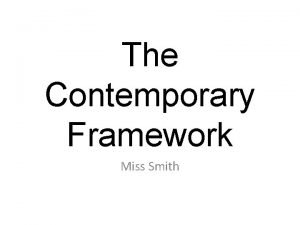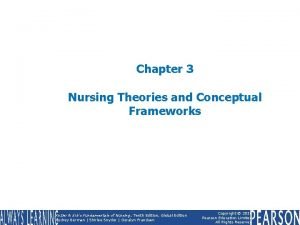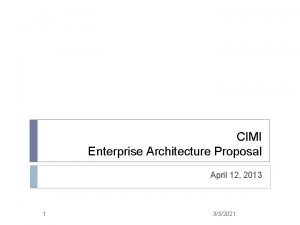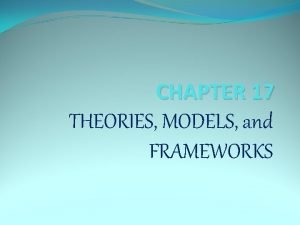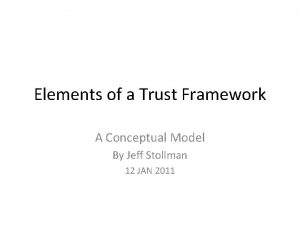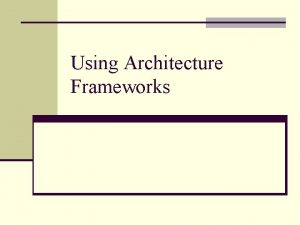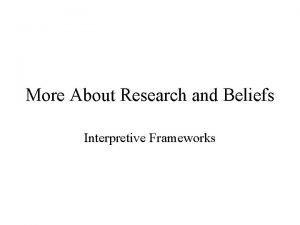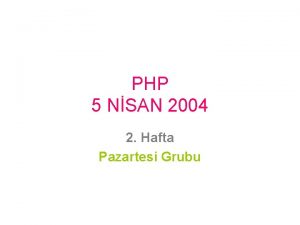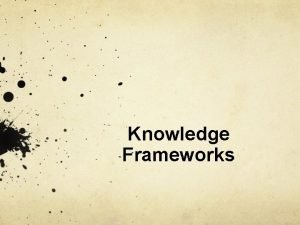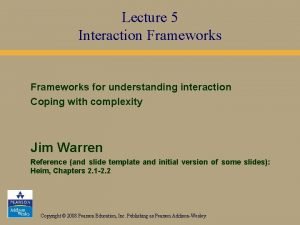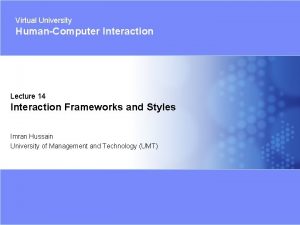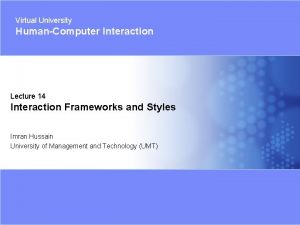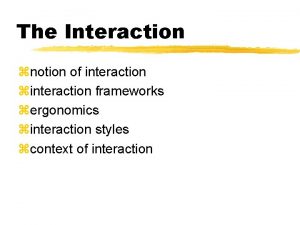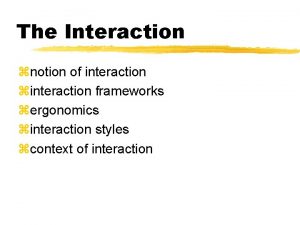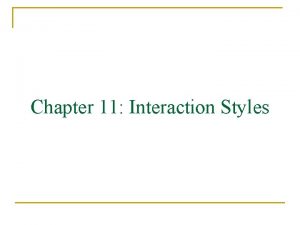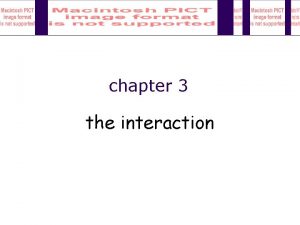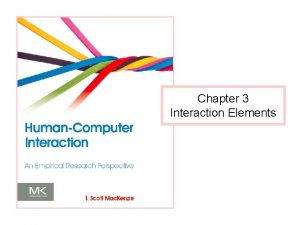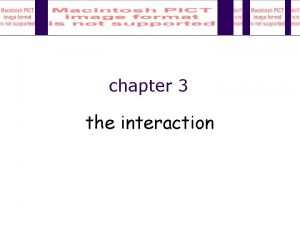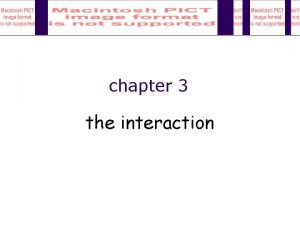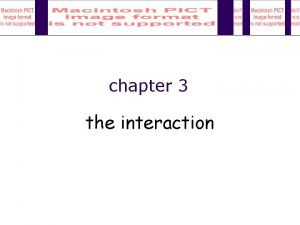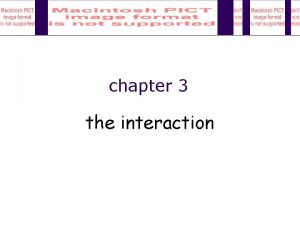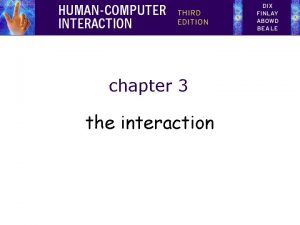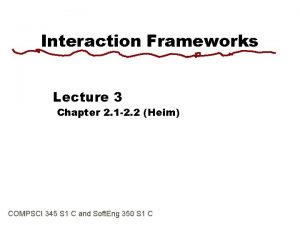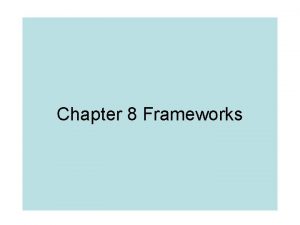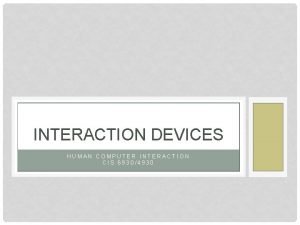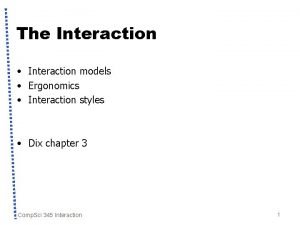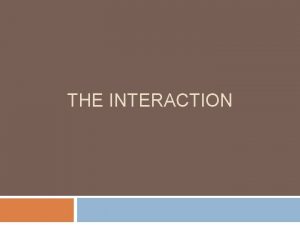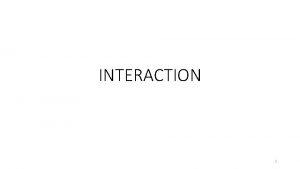Interaction Frameworks Lecture 3 Chapter 2 1 2
























- Slides: 24

Interaction Frameworks Lecture 3 Chapter 2. 1 -2. 2 (Heim) COMPSCI 345 S 1 C and Soft. Eng 350 S 1 C

Interaction Frameworks • Frameworks for Understanding Interaction • Execution/Evaluation Action Cycle (Norman’s model) • Interaction Framework (Abowd & Beale’s) • Coping with Complexity • • Mental models Mapping Semantic & Articulatory Distance Affordances © Heim 2008 2

Frameworks for Understanding Interaction • A framework is basically a structure that provides a context for conceptualizing something • We can use these frameworks to: • Structure the design process • Help us to identify problematic areas within the design • Help us to conceptualize the problem space as a whole © Heim 2008 3

Execution/Evaluation Action Cycle (EEC) • Donald Norman’s model concentrates on user’s view of the interface • The structure of an action has four basic part: • Goals: We begin with some idea of what we want to happen; this is our goal. • Execution: We must then execute an action in the world. • World: To execute and action, we must manipulate objects in the world. • Evaluation: Finally, we must validate our action and compare the results with our goal. © Heim 2008 4

Execution/Evaluation Action Cycle (EEC) • Goals do not specify particular actions • Goals and intentions do not have a one-to-one, relationship • “Delete text” goal • Intention that involves the Edit menu • Intention that involves the Delete key • Each intention involves a sequence of actions Goal > Intention > Actions > Execution © Heim 2008 5

Execution/Evaluation Action Cycle (EEC) • Evaluate Results • Perceive new state • Interpret what we perceive • Evaluate new state with goal (compare results with the goal) Perceive > Interpret > Evaluate © Heim 2008 6

Execution/Evaluation Action Cycle (EEC) • Seven Stages of Action © Heim 2008 7

Execution/Evaluation Action Cycle (EEC) • The seven stages form a cycle • The cycle can be initiated at any point • Some goals are data-driven - initiated when an environmental event is perceived (formulated ad hoc as opportunity arises) • Others are goal-driven - initiated when the person conceives of a new goal (thought out in advance) © Heim 2008 8

Gulf of Execution • User’s formulation of actions ≠ actions allowed by the system • Does the interface allows us to carry out the actions required by the intention? Goal = save a file Intention = use the file menu Action = click the save option • Is there a save option in the file menu? © Heim 2008 9

Gulf of Evaluation • User’s expectation of changed system state ≠ actual presentation of this state • Given a particular interface design, how easily can you: • • Determine the function of the device? Determine what actions are possible? Determine mapping from intention to physical movement? Perform the action? Determine whether the system is in the desired state? Determine the mapping from system state to interpretation? Determine what state the system is in? (Norman, 1990) 10

Human error - slips and mistakes The model affects user errors • slip understand system and goal correct formulation of action incorrect action • mistake may not even have right goal! Fixing things? slip – better interface design © 2004 Dix et al. mistake – better understanding of system 11

Interaction Framework • Abowd and Beale expanded on the EEC to include the system • System (S)—Uses its core language (computational attributes related to system state) • User (U)—Uses its task language (psychological attributes related to user state) • Input (I)—Uses its input language • Output (O)—Uses its output language Presentation O Observation output S U core task Performance I input Articulation • each has its own unique language interaction translation between languages • problems in interaction = problems in translation © Heim 2008 12

Interaction Framework / EEC • Execution Phase Presentation O • Articulation—The user formulates output a goal, which is then articulated using S the input language. core • Performance—The input language I input is translated into the core language Performance (operations that the system will carry out). • Presentation—The system manifests the result of the core-language operations using the output language. Observation U task Articulation • Evaluation Phase • Observation—The user interprets the results on the screen and reconciles them with the original goal. 13 © Heim 2008

Interaction Framework • general framework for understanding interaction • • not restricted to electronic computer systems identifies all major components involved in interaction allows comparative assessment of systems an abstraction © Heim 2008 14

Coping with Complexity • • Mental Models Mapping Semantic and Articulatory Distance Affordances © Heim 2008 15

Mental Models • A mental model is a cognitive representation of something that defines a logical and believable estimation as to how a thing is constructed or how it functions • Transparent objects expose their functions • Bicycles • Opaque objects hide their functions • Computers • Designs that align with a user’s mental model will be easier for him or her to use © Heim 2008 16

Mental Models • Mental models are: • Unscientific—They are often based on guesswork and approximations. • Partial—They do not necessarily describe whole systems, just the aspects that are relevant to the persons who formulate them. • Unstable—They are not concrete formulations, but evolve and adapt to the context. • Inconsistent—They do not necessarily form a cohesive whole; some parts may be incompatible with other parts of the same model. • Personal—They are specific to each individual and are not universal concepts that can be applied generically. © Heim 2008 17

Mapping • The concept of mapping describes how we make connections between things • Proper mapping can increase the usability of an interface • Use natural mapping whenever possible Arbitrary mapping © Heim 2008 Arbitrary mapping improved Natural mapping 18

Semantic and Articulatory Distance • Semantic Distance • The distance between what people want to do and the meaning of an interface element. • Articulatory Distance • The distance between the physical appearance of an interface element and what it actually means. © Heim 2008 19

Affordances • The affordances of some interfaces can be intuitively understood: a steering wheel affords turning, and a door bell affords pushing. • These connections allow us to make predictions about the results of our actions and help us to create usable mental models. © Heim 2008 20

Affordances • Affordance Confusion - when certain aspects of an object do not work in a way in which we assume they should • Norman considers an affordance to be a relationship between an object and a user, not a property of an object © Heim 2008 21

Affordances • What may be an affordance to one person may not be to another • The perception of affordance fosters usability • The affordances a user may need must be present • Affordances must not contradict the user’s expectations © Heim 2008 22

Summary • General lesson • If you want someone to do something • Make it easy for them • Understand their values • Can use interaction frameworks to help you design your system • Consider ways in which you can help users to cope with complex environments • Next lecture: Interaction Styles (Heim Ch. 2. 3), We will use the frameworks we have learned about today to look at different interaction styles 23

Questions • Describe the “Gulf of Execution” with an example and give a reason as to its importance in the development of software interaction? 24
 01:640:244 lecture notes - lecture 15: plat, idah, farad
01:640:244 lecture notes - lecture 15: plat, idah, farad Strategic management frameworks
Strategic management frameworks Sub topic sentence
Sub topic sentence Non traditional art
Non traditional art Parcc model content frameworks
Parcc model content frameworks The living tree of nursing theories
The living tree of nursing theories Java ecommerce framework
Java ecommerce framework List of theoretical frameworks
List of theoretical frameworks Architecture frameworks
Architecture frameworks Nursing informatics theories, models and frameworks
Nursing informatics theories, models and frameworks Enterprise agile frameworks
Enterprise agile frameworks Why i hate frameworks
Why i hate frameworks Social studies frameworks
Social studies frameworks Food security concepts and frameworks
Food security concepts and frameworks Describe trust frameworks.
Describe trust frameworks. Actor frameworks
Actor frameworks A level english language frameworks
A level english language frameworks Software architecture frameworks
Software architecture frameworks Post positivism
Post positivism Regional construction frameworks
Regional construction frameworks Interpretive frameworks
Interpretive frameworks Slidetodoc
Slidetodoc Net frameworks 4
Net frameworks 4 Local development frameworks
Local development frameworks Knowledge framework
Knowledge framework



